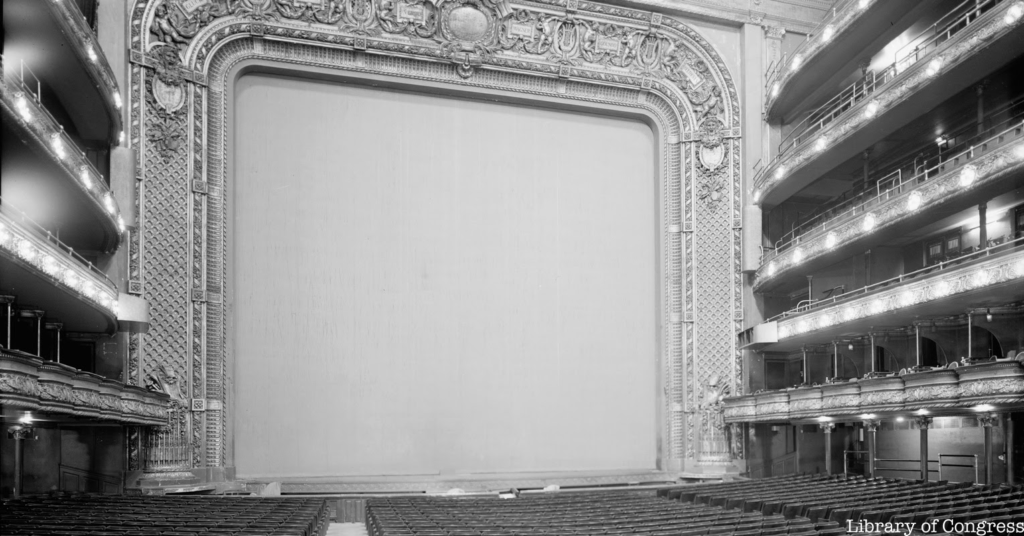Friday – Sunday, April 26-28, 2024 – UGLY ON THE EXTERIOR, BUT GREAT MUSIC INSIDE



APRIL 26-28, 2024
VINTAGE PHOTOS:
NYC’S LOST
METROPOLITAN OPERA
HOUSE
ISSUE # 1227
Untapped New York

Front View of the Met, 1966. Image via The Library of Congress
Most would find it surprising that The Metropolitan Opera Management sued to have their own opera house razed, but that is exactly what happened in the mid-1960s. The Metropolitan Opera Association had plans to relocate to Lincoln Center and feared competition from a new opera company taking over the existing location. The history of this early opera house was rife with drama from its opening in 1883 until its eventual demolition.
Part of the reason the association wanted to relocate was because of the opera house’s plain, and what some called ugly, exterior. The opera house, done in the Italian Renaissance style, was even dubbed a “third-rate warehouse.” The exterior gave no hint of the building’s lavish interior. It was designed to be more extravagant than the competition, The Academy of Music.

The architect, J. Cleveland Cady was responsible for the design of the building in 1883. The creation and opening of the Metropolitan Opera House was a major storyline in Season 2 of HBO’s period drama The Gilded Age. In the show, as in real life, the dueling opera houses illustrated the battle between new and old-money New Yorkers of the upper class. Three separate locations were used by production to recreate the building for the show. Learn how they did it here!
After a fire in 1892, architects Carrere and Hastings redesigned the interior. They created a gold auditorium which included the largest proscenium in America at the time, inscribed with the names of six composers: Beethoven, Gluck, Gounod, Mozart, Verdi, and Wagner. The famous gold damask stage curtain was not installed until 1906. The two architects also restored the opera house’s Diamond Horseshoe box seats, coveted spots from which the Vanderbilts and Astors watched performances, along with five thousand others.
Even though the opera house was beautifully designed, it was not guaranteed to be designated as a historical landmark. Starting in September of 1965, before the building was demolished, a year-long dispute occurred between the Metropolitan Opera Association, the New York City Landmarks Association, and a variety of composers, musicians, and New Yorkers who spent their time at the opera house.
The New York City Landmarks Association considered the opera house as one of their first buildings for landmark designation. Because of the opera management’s opposition and the questionable quality of the architecture, the landmark association voted not to preserve the building. Unhappy with the decision, New York City Mayor Lindsay and Governor Rockefeller formed the Old Opera House Committee with the goal of preserving the Opera House.

Met Street View, 1966. Image via The Library of Congress
In April 1966, the last month of opera performances, New Yorkers affiliated with the opera house were still making attempts to save it. Ten days before what would be the last performance, a group of composers, actors, and musicians made a final effort to save the building. They planned to raise $8 million dollars to buy the opera house from the Metropolitan Opera Association. The association countered saying they would make almost double that amount of money if they leased it to a development firm. During the last opera performance, on April 16, 1966, the conductor, Leopold Stokoski made a final and simple plea from the podium: “I beg you to save this magnificent house.”

Outside, 1914. Image via The Library of Congress
Displeased with all the hoopla, the opera management sued and in August of 1966 the verdict was that all preservation efforts be suspended. In January of 1967, the Metropolitan Opera House was destroyed; three years later, the bland, 40-story World Apparel Center at West 39th Street and Broadway was built on the site and still stands there today.

The old Metropolitan Opera House has become a prime example for preservationists of what should still be standing, along with the original Penn Station which was demolished in 1963. Had the Landmark Commission had more experience giving buildings historical status, maybe the opera house would still hold performances at West 39th St and Broadway. Check out more photos of the theater in the gallery below!
FRIDAY PHOTO
THE AL WEINSTEIN COMMEMORATIVE
CHERRY TREE AT THE TRAM PLAZA.
AL WAS AN EARLY RESIDENT WHO CAMPAIGNED
FOR THE TRAM IN THE 1980’S.




Leave a comment